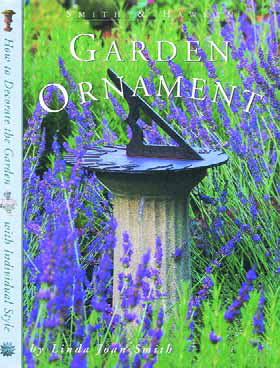Art of the Ornament

So often it’s the finest or most delicate touches that make or break backyard projects – and exploring the constituents of those touches is what Garden Ornament by Linda Joan Smith (Workman Publishing, 1998) is really all about.
This beautifully illustrated, 136-page book tackles head on the often overlooked subject of garden ornamentation and, in doing so, pulls back the veil on a remarkably rich set of design touches and specific objects you can use to lend interest to your projects, generate enthusiasm among your clients and, ultimately, give your projects real visual energy.
That set of ideas includes items that can be used to add beauty and even sentimental value to any outdoor setting, such as statuary of all kinds, pots, ceramic pieces, fountains, birdhouses and birdbaths, sconces, sun dials, obelisks, scarecrows, totem poles, wood carvings and a broad range of antiquities, from old farm equipment and wheelbarrows to family heirlooms.
From the opening pages, Smith argues that these items, when properly selected and placed, can transform the garden experience by adding character and vibrancy to these spaces, lending them a sense of uniqueness and thus giving the designer a powerful set of tools with which to draw the client into the process. On each page, she offers beautiful photos that serve on their own as a catalog of ideas – many of which I’ve found enormously useful in developing my own designs.
Smith digs sensibly and deep, offering a chapter on the history of garden ornamentation; another on managing placement, setting and the use of ornaments to create movement and surprise; and yet another on how certain types of ornaments work visually through the four seasons.
I’ve long been particularly impressed by her smart discussion of the regional character of certain ornaments – and with her informative treatment of the differing characteristics of raw materials such as bronze, ceramics and plastic resins. Her suggestions on strategies for weaving items of sentimental value to clients into decorative settings are also first rate and valuable.
What all of this ultimately leads to, at least from the perspective of a watershape designer, is that these decorative items should never be treated as afterthoughts and should instead be considered, as are so many other features of the finest projects, as integral to the design from the start. She advocates, for example, designing walls and patios areas with pedestals for pots, statues or other decorative objects: By planning for the placement of these items in the garden design from the outset, she believes you can maximize their effect.
Smith also includes a wonderfully helpful and comprehensive resource guide, giving her readers direct entrée to many of the objects she covers in her book.
With perfect candor, I must say that I’ve held back on covering Garden Ornament in “Book Notes.” It’s long been a favorite of mine, and I know I’m sharing a private resource that’s always inspired me to seek creative ways to personalize the aesthetics of the spaces I design. It has certainly led me to open up my thinking about garden ornaments, and I encourage anyone engaged in the art of watershaping or garden design to pick up this book and do the same.
Mike Farley is a landscape designer with more than 20 years of experience and is currently a designer/project manager for Claffey Pools in Southlake, Texas. A graduate of Genesis 3’s Level I Design School, he holds a degree in landscape architecture from Texas Tech University and has worked as a watershaper in both California and Texas.










